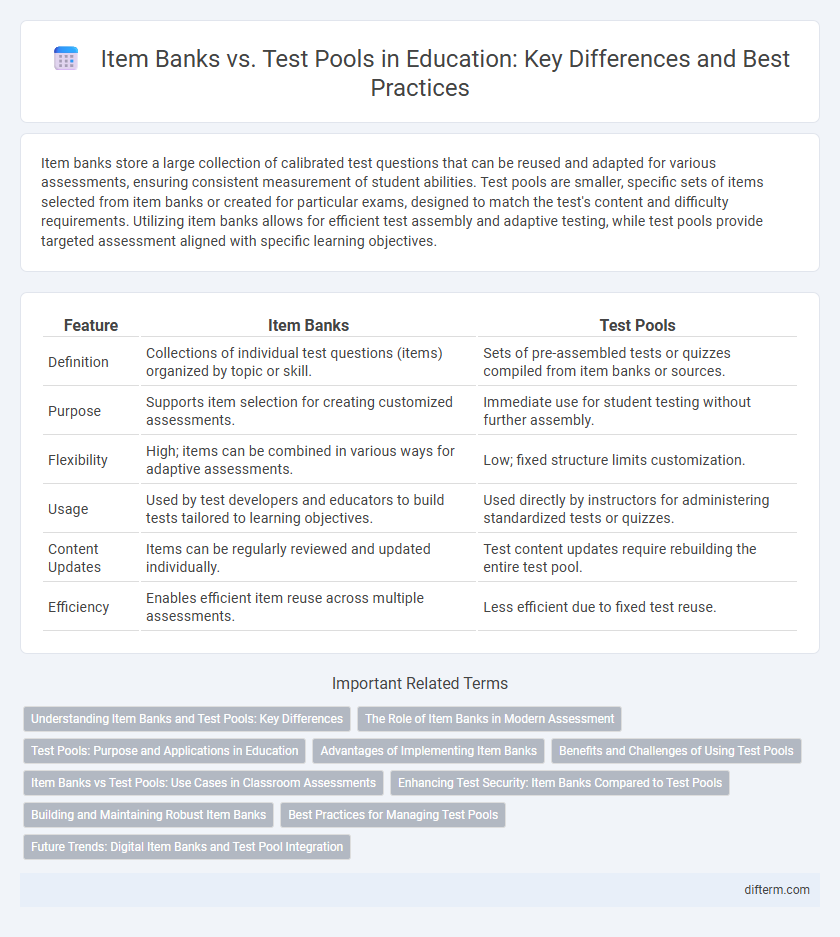Item banks store a large collection of calibrated test questions that can be reused and adapted for various assessments, ensuring consistent measurement of student abilities. Test pools are smaller, specific sets of items selected from item banks or created for particular exams, designed to match the test's content and difficulty requirements. Utilizing item banks allows for efficient test assembly and adaptive testing, while test pools provide targeted assessment aligned with specific learning objectives.
Table of Comparison
| Feature | Item Banks | Test Pools |
|---|---|---|
| Definition | Collections of individual test questions (items) organized by topic or skill. | Sets of pre-assembled tests or quizzes compiled from item banks or sources. |
| Purpose | Supports item selection for creating customized assessments. | Immediate use for student testing without further assembly. |
| Flexibility | High; items can be combined in various ways for adaptive assessments. | Low; fixed structure limits customization. |
| Usage | Used by test developers and educators to build tests tailored to learning objectives. | Used directly by instructors for administering standardized tests or quizzes. |
| Content Updates | Items can be regularly reviewed and updated individually. | Test content updates require rebuilding the entire test pool. |
| Efficiency | Enables efficient item reuse across multiple assessments. | Less efficient due to fixed test reuse. |
Understanding Item Banks and Test Pools: Key Differences
Item banks are large, organized repositories of test questions designed for broad use across multiple assessments, enabling educators to select and customize items efficiently. Test pools refer to smaller, fixed collections of test items assembled for a specific exam or purpose, limiting adaptability compared to item banks. Understanding these distinctions helps educators optimize test design, ensuring balanced item selection and consistent assessment quality.
The Role of Item Banks in Modern Assessment
Item banks serve as extensive repositories of vetted test questions that enable adaptive testing and consistent assessment creation across diverse educational settings. They facilitate efficient item selection, ensuring alignment with learning objectives and maintaining test security by rotating items from a broad pool. Leveraging item banks supports data-driven insights through item statistics, improving test validity and reliability in modern assessment frameworks.
Test Pools: Purpose and Applications in Education
Test pools serve as curated collections of assessment items designed to streamline the test creation process, improving efficiency and consistency in educational evaluation. They facilitate adaptive testing by providing a diverse range of question types and difficulty levels tailored to various learning objectives and standards. Educational institutions leverage test pools to ensure rigorous alignment with curriculum goals and to support data-driven insights into student performance.
Advantages of Implementing Item Banks
Implementing item banks in education enhances assessment efficiency by providing a centralized repository of calibrated, validated questions that support adaptive testing and customized exam creation. These banks allow for consistent item quality and statistical analysis, improving reliability and validity across multiple test forms. Educators benefit from reduced test development time and the ability to track item performance, facilitating continuous improvement in assessment design.
Benefits and Challenges of Using Test Pools
Test pools in education provide a flexible repository of questions that can be assembled into different assessments, promoting varied and adaptive testing experiences while reducing test predictability. They enable efficient test construction and item reuse, saving educators time and resources. However, challenges include ensuring item quality, maintaining consistency in difficulty levels, and managing large databases to avoid content overlap and bias.
Item Banks vs Test Pools: Use Cases in Classroom Assessments
Item banks serve as comprehensive repositories of validated questions designed for diverse assessment purposes, facilitating adaptive testing and precise measurement of student learning outcomes. Test pools, typically smaller and curated collections, are tailored for specific quizzes or exams, allowing teachers to efficiently assemble balanced assessments aligned with lesson objectives. Utilizing item banks enhances long-term assessment strategy by enabling data-driven question selection, whereas test pools offer practical, immediate resources for classroom-level evaluation.
Enhancing Test Security: Item Banks Compared to Test Pools
Item banks offer a structured repository of calibrated test questions that are systematically reviewed for quality and security, significantly reducing the risk of item exposure compared to traditional test pools. Their controlled access and regular item rotation ensure enhanced protection against cheating and item leakage, promoting test integrity. In contrast, test pools often lack rigorous management, making them more vulnerable to compromised questions and undermining overall assessment security.
Building and Maintaining Robust Item Banks
Building and maintaining robust item banks requires systematic categorization, regular calibration, and continuous quality review to ensure item validity and reliability. Unlike test pools, item banks benefit from detailed metadata tagging and adaptive algorithms that facilitate dynamic test assembly and personalized assessment. Efficient management of item banks enables scalable, consistent test development that aligns with learning standards and evolving educational needs.
Best Practices for Managing Test Pools
Effective management of test pools involves organizing a large collection of test items categorized by subject, difficulty, and cognitive level to ensure comprehensive coverage. Regularly updating and reviewing items based on student performance data enhances the reliability and validity of assessments. Implementing secure access controls and version tracking maintains the integrity of the test pool for consistent and fair testing outcomes.
Future Trends: Digital Item Banks and Test Pool Integration
Digital item banks are evolving to incorporate advanced metadata tagging and adaptive algorithms, enabling more dynamic and personalized test generation. Test pool integration leverages cloud-based platforms to facilitate seamless sharing and real-time updates, enhancing collaborative assessment development. Emerging trends point toward AI-driven analytics that optimize item selection and improve test validity across diverse educational settings.
item banks vs test pools Infographic

 difterm.com
difterm.com